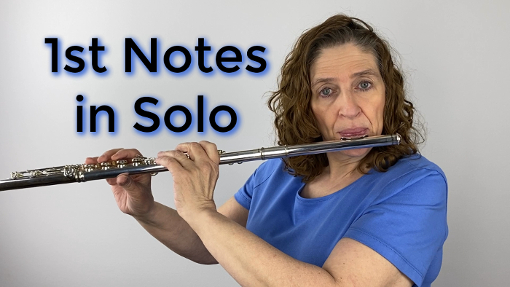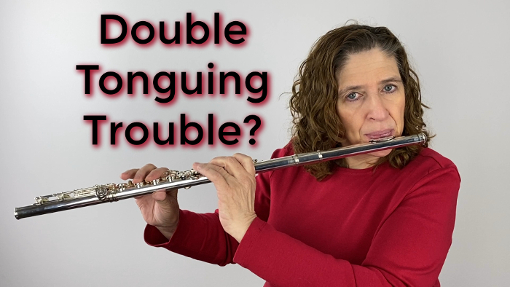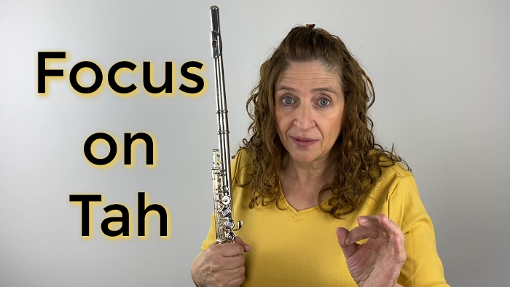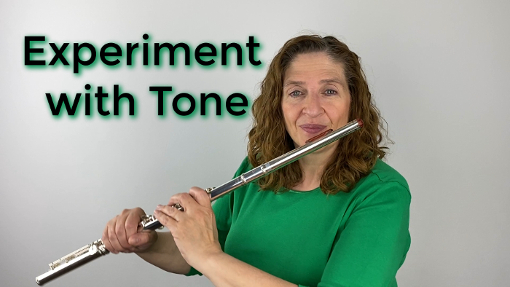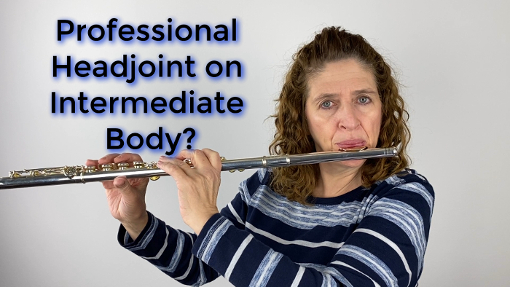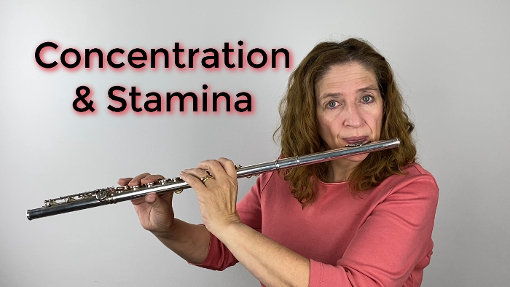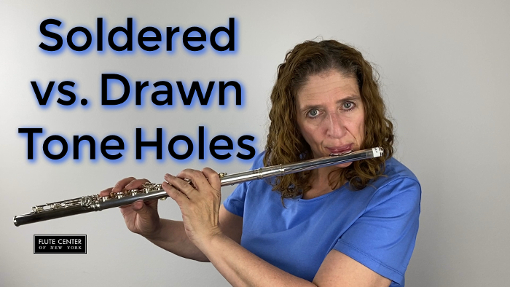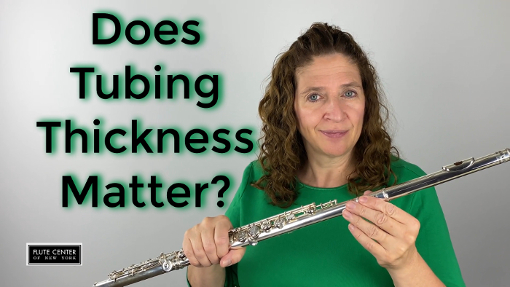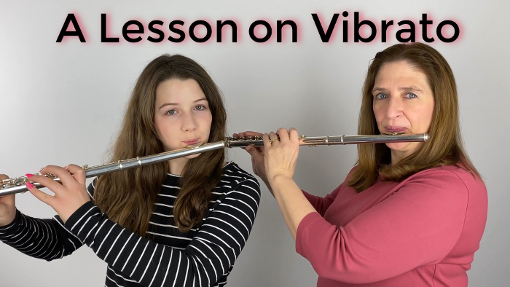FluteTips
Ideas that you can use right now to improve your flute performance!
Here’s a sample of over 225 videos at:
Playing the First Notes of Your Solo – FluteTips 186
Do you plan the very first note of your solo performance? What you do with that first note is crucial. It sets the tone for the whole piece, literally and figuratively.
Does that first note have a fabulous tone, vibrato, liveliness, and color? Does it tell us what’s coming next?
Here’s how to make sure that the very first note has presence.
Have fun!
DoctorFlute
Do You Have Trouble with Your Double Tonguing? FluteTips 185
I am not going to talk about the syllables you use when you double tongue.
But does that syllable make a sparkly sound like the closing of a drum set cymbal?
Does the roof of your mouth need a massage when you finish double tonguing?
Here’s how you can learn effortless double tonguing.
Have fun!
DoctorFlute
Blowing Across the Wet – FluteTips 184
What does it mean to blow across the wet?
Well, I know it seems like a funny expression. But to get the kind of tone that you want, you need to let the air hit the inside of your lower lip. It may even blow across the inside of the upper lip.
When you do this right, the air feels cold because of the warm air hitting the wet of your lips.
It’s a way for you to loosen up your embouchure while giving your tone a clear unobstructed path to come out and blossom.
Comparing 3 Professional Flutes Haynes Powell Brannen – Flute Center Sponsored
In this video I compare 3 professional model flutes. All silver. All handmade. All hand cut. All beautiful. All sound different.
Watch as I describe and play each individually. Then at the end I put clips of each 3 side-by-side for you to easily compare. Which do you like the best?
Have fun!
DoctorFlute
Losing Your Tone While Performing – FluteTips 183
Have you ever been performing a piece only to find that your tone gets worse as you go along? I remember discovering this in college. Even when practicing went well, in a performance my tone would get thin, and I might even lose my low register!
Part of the cause could be the tension from performance anxiety. Rather than relaxing, you get tighter with each measure. But a bigger part of the tension in your playing is understanding how to adjust your embouchure, and your breathing.
The real trick to not losing your tone while you perform is learning how to loosen your embouchure, and when to adjust the embouchure shape, widen your teeth spacing, and even out your breathing.
Have fun!
DoctorFlute
Why Are Professional Flutes So Expensive? Flute Center Sponsored
Professional flutes are well worth the money because they are such a joy to play. They are so much better than even the best intermediate flutes. But why are they so expensive? And is there anything that you can do to drive down the cost?
Read my Blog for the full rundown where I look at 8 categories: metal, maker, mechanism, headjoints, tubing, pads, extras, and maintenance. I will point out if and where you can compromise, and what that will cost you in dollars and performance value.
Have fun!
DoctorFlute
Tight Embouchure No Problem – FluteTips 182
You might be confused to read that a tight embouchure is not a problem, because you know, or at least you have heard that a tight embouchure is a problem. It is true that you do not ever want to play flute with a tight embouchure.
NOT EVER
It will give you a tight sound and it hurts your tone.
What I mean then is that if you have a tight embouchure, it is no problem for you to fix it. You can learn to play without a tight embouchure, which will noticeably improve your tone.
In this blog and video, we discuss how your embouchure probably got tight when you started playing the flute and got dizzy. Then we’ll explore some ideas to fix a tight embouchure.
Have fun!
DoctorFlute
Failure to Plan for Your 3rd 8va Notes is a Plan to Fail – FluteTips 181
Have you ever missed a high note? What I mean is that instead of hitting that 3rd octave like a champ, you cracked! It’s not pretty, but we’ve all done it somewhere in our performances.
There is a way to prevent that from happening. I’ve learned that I can prevent a 3rd octave catastrophe when I’ve done my prep work ahead of time. It is all about planning first, then practicing your plan.
You’ve heard the expression “failing to plan, is planning to fail.” In this video I explain how to plan ahead, so that you won’t fail in your third octave.
Have fun!
DoctorFlute
Flute Review North Bridge Intermediate Flutes 500-600-700–Flute Center Sponsored
I’ve partnered with the Flute Center to do a review of the North Bridge intermediate level flutes. These are step-up flutes with a hand cut headjoint.
I will play and compare 3 levels of North Bridge – the Series 500, Series 600, and the Series 700. There are some differences between these three (pointed vs. Y-key arms, sterling silver body vs. silver-plated body, and C# trill key) but could you HEAR the difference? I could.
Join me for this week’s video and let me know if you could pick out the differences in these 3 step-up flutes.
Have fun!
DoctorFlute
Arm Placement for Better Tone – FluteTips 180
Have you ever really thought about the placement of your arms when playing flute? What do your arms do? Some people let their arms hang, some bring the left elbow up, some look like their arms are barely holding the flute up, and some keep them rigidly out marching band style.
Do you know that arm placement can influence your tone? It can also affect the long-term health of your flute playing.
There is a lot to think about with the positioning of the arms to help create the most relaxed yet functional flute playing, and the surprising thing is that it can affect tone as well.
In this video I will explain proper arm positioning to help create the best flute player in you!
Have fun!
DoctorFlute
Let’s Talk Articulation – Focus on Your Tah – FluteTips 179
How is your articulation? Do you feel that your tonguing is precise and clear? Or do you sometimes have articulated notes that are unfocused and airy?
There are differing ideas on tongue placement, and I think they can all be used for various reasons. But I want to discuss the unfocused Tah sound. You know that one especially in the low register where sometimes it’s a puff of air rather than good tone quality.
In this video I discuss the exact position of the tongue necessary for a good clear Tah using embouchure, tongue, and support.
Have fun!
DoctorFlute
Silver vs Silver-Plated North Bridge 700 vs 500 Step-Up – Flute Center Sponsored
I am doing a Flute Center trial of North Bridge Step-Up flutes. You know that I’ve done comparisons before. But this time I wanted to use the same exact headjoint, to compare a sterling silver body to a silver-plated body.
So, the headjoint is sterling silver handmade by flute artisan Chris McKenna. The intermediate level flute bodies are the North Bridge Flutes Series 700 and the Series 500. The 700 has a sterling silver body, and the 500 has a silver-plated body. The 700 also has the C# trill key. Otherwise, these flutes are identical.
This is exactly what I wanted so that I could do an “apples to apples” comparison of silver vs. silver-plated. In today’s market, there is an $1,100 difference in price between these two flutes. But can you tell the difference? I sure could.
Have fun!
DoctorFlute
Resonate to Improve Your Tone – FluteTips 178
Do you resonate your tone? What does that really mean?
Today I’m talking to you about resonation or what makes a tone vibrant and alive. There are 3 things you can do to make your tone resonate. When you use resonation to improve your tone, you will be surprised at how much you like it!
A tone that resonates is going to make people stand up and take notice. So, let’s talk resonation!
Have fun!
DoctorFlute
Learning How to Breathe Deeply and Quickly – FluteTips 176
How are your quick breaths in the middle of a piece? Do you always take a deep full breath that fills up your support every single time?
It is difficult to train yourself to take a deep breath in the middle of a piece. We can often take a really good breath at the beginning of the piece, or after a long rest. But it is much harder to take that deep full open throat breath as you are playing. Especially when you are moving really fast, and you have only a split second to take that breath.
Deep breathing is necessary to create the air pressure that enables you to create a good tone. In this video, I will teach you how to practice taking that type of breath in the middle of a piece so that every single time you need a breath, whether slow or fast, it is always the right breath to help you play well.
Have fun!
DoctorFlute
Experimenting with Tone – FluteTips 176
Sometimes I have bad tone days! Don’t you?
Even when I am in good shape from a steady diet of practice, rehearsals, and performances, I can still have a bad tone day.
So, what can we do to pull out of the doldrums and make it a good tone day? I remember during my college years when I had bad tone days, all I did was technique. Just the thought of doing long tones turned my stomach! Working on technique was my fallback practice routine.
Here’s how you experiment to fix your tone while you are working through your technique.
Have fun!
DoctorFlute
Hernández Headjoints Flute Review Las Cabezas en Madera
The Flute Center of New York sent me 7 Hernández headjoints to test and compare on a Haynes professional model silver flute body. 2 of these headjoints really WOWed me!
Hernández headjoints come in multiple styles made from a variety of wood types, or metals with a wood lip plate and crown. This wood added to your headjoint gives you a mellow sound. It mellows out that silvery brightness or that gold honey sound. It will also warm up your tone. Your sound will change substantially because wood vibrates differently than metals.
Which las cabezas en madera do you like best?
Have fun!
DoctorFlute
Flute Review Apple Red Guo Tocco C-Flute – FCNY Sponsored
The Flute Center of New York sent me an Apple Red Guo Tocco C-Flute to review, plus a handcut headjoint to switch out and try. Here’s a summary of what I covered:
2-Year Warranty, 1 piece case, Weight, Texture, Composite, Hardy, Price, Embouchure placement, Tone, With a hand cut head.
Have fun!
DoctorFlute
Learning How to Taper – FluteTips 174
Learning how to taper can be really annoying. But it’s beautiful when you learn how to do them. Tapering is simply how you end your notes. No matter how long or how short, they need to have an ending. It’s this little bit of a pull at the end of your note that makes a beautiful ending.
There’s a short tone exercise in Moyse’s De La Sonorite that I like to use for short tapers that still have resonance. It’s where I learned how to do short tones and short tapers.
Tapers will make your music so much more beautiful.
Watch me demonstrate eighth note tapers in the Hindemith Sonata!
Have fun!
DoctorFlute
Does the Cut of Your Lip Plate Make a Difference on a Professional Silver Flute – FCNY Sponsored
The Flute Center of New York sent me 2 beautiful Powell hand-cut sterling silver headjoints to compare the cuts of their lip plates. One headjoint has the Venti cut, the other has the Philharmonic cut. Both have a 14K gold lip plate and riser.
I compared them on the same gorgeous Powell handmade custom flute in Sterling silver.
Just like the gold flute comparison of Lumina & Philharmonic cuts, the sound of the silver headjoints was clearly different. Powell calls the Venti their “powerhouse” headjoint cut.
But can you hear the difference? How much resistance do you prefer?
Listen in as I comment on what I hear and feel as I play on each of these headjoints.
Have fun!
DoctorFlute
Does the Cut of Your Lip Plate Make a Difference on a Professional Gold Flute? FCNY Sponsored
The Flute Center of New York sent me 2 beautiful Powell hand-cut 14K rose gold headjoints to compare the cuts of their lip plates. One headjoint has the Lumina cut, the other has the Philharmonic cut.
I compared them both on the same gorgeous Powell handmade 14K rose gold flute.
Wow! What a huge difference between them! Their sound was clearly different. But what was instantly noticeable and distinctly different was their responsiveness and resistance.
Can you hear the difference? How much resistance do you prefer?
Listen in as I comment on what I hear and feel as I play on each of these headjoints.
Have fun!
DoctorFlute
Getting Spin on Your Third Octave Notes – FluteTips 171
How many of you feel like your third octave just does not have the same kind of resonance and excitement that perhaps your second and your first octave do? Learning how to “spin” your notes is one way to add that excitement to your high notes.
How do you spin?
- Start with a loose embouchure
- Make sure you have support pushing up on your high notes
- Jiggle that tone
- Have a cavern inside so that tone can resonate
This is how your get spin on your third octave notes.
Have fun!
DoctorFlute
Should You Put a Professional Headjoint on an Intermediate Body? FluteTips 170
The only reason that you would consider putting a professional model hand cut headjoint on an intermediate flute is to save money. If you wanted to improve your flute tone, and you had enough money to spend on a professional model flute, then you would just buy the better flute.
I did a test with my daughters Haynes Amadeus intermediate flute by swapping out the headjoint with a Powell Sterling Silver hand cut headjoint with a 14-Karat gold lip plate and riser with the Venti cut. This Powell headjoint is truly a beautiful head!
Which headjoint sounds better to you?
Have fun!
DoctorFlute
LefreQue for Flute Testing 4 LefreQue on 3 Flute Levels – FCNY Sponsored
The Flute Center of New York sent me 4 different versions of the LefreQue Sound Bridge to test. I had a lot of fun testing them out on my professional flute as well as my daughters’ intermediate and beginner flutes.
Watch as I demonstrate how the LefreQue Sound Bridge can actually change the sound (and feel) of 3 levels of flute; answer some of the most commonly asked questions that I have gotten about the LefreQue; and include some details about an independent test conducted by a peer-reviewed scientific journal.
Have fun!
DoctorFlute
How to NOT Go Flat at the End of Notes – FluteTips 168
Do you find that you go flat at the end of a long phrase?
It’s quite common when you run out of air or lose your support. But you can keep those notes on pitch even when you’re running out of air by working on tapers, keeping the airstream up, and keeping up the support – or what I like to call pressure.
Join me in today’s FluteTip as I explore these ideas.
Have fun!
DoctorFlute
Flute Review Lillian Burkart Professional Model Silver with 14K Riser – FCNY Sponsored
I’ve partnered with the Flute Center of New York to review this beautiful Lillian Burkart Professional Model Sterling Silver flute with 14K gold Riser. You may not be in the market for a professional model flute, but it sure is fun to play such a well-made instrument!
Listen for the tone and response time as I tongue & slur, do some low register tonguing, try to get an edgier sound as well as a Baroque sound, and push the top of the range in the 3rd octave. I will also discuss the mechanism and how this flute feels in my hands, and the fact that you have to get used to a new flute.
Have fun!
DoctorFlute
Loosening Your Embouchure While You Are Playing – FluteTips 165
Have you ever lost your low notes during a recital, or solo festival, or even in an ensemble? It is very common for flutists to be able to get a really rich low register in the practice room right before a performance only to lose those bottom notes on stage.
It is so frustrating to barely be able to get a good tone quality when you get to the low notes in your piece. If this has happened to you, you know exactly what I mean.
When you identify the cause of the problem, you can start working on solutions.
Have fun!
DoctorFlute
How Not to Crack on Your Middle Register Notes – FluteTips 164
I really detest cracking notes. It is one of those pet peeves that drive you crazy. One of the areas where it happens a lot is in the middle register. Those notes can often be what I call the caught-in-between sound. You know that sound when the notes isn’t quite up high enough, and it gets both a low and a high sound at the same time? I know how to fix it, but it still happens from time to time.
How about you? Does that sound ever come out of your flute? Let’s see if I can help you.
Have fun!
DoctorFlute
Woodify Ring for Flute Review by DoctorFlute – FCNY Sponsored
Have you heard of the Woodify Ring for Flute? It’s a wooden ring you fasten to your headjoint to improve your tone in various and mysterious ways. I made a video of myself testing 3 different Woodify Rings: Cherry Wood, Walnut, and Beech Wood.
All 3 rings noticeably changed the sound of the flute and produced different sounds than the other rings.
But do they measure up to the manufacturer’s promises?
Have fun!
DoctorFlute
Concentration and Stamina in Your Playing – FluteTips 162
Concentration and stamina are two areas of flute playing that we all need to work on. These are skills that you can learn.
Have fun!
DoctorFlute
Getting a Better Tone Quality on Middle C, C#, D, Eb – FluteTips 160
How are your middle register notes? Not the best? This is a very common problem. These pesky notes can be difficult to get a good tone quality. The tone on these middle notes is often thin at best. What is the reason for that and how do you fix it?
The reason that the sound is bad is because it is more difficult to achieve harmonics when the flute is essentially shorter. However, there are ways to work with the flute and get these harmonics in the tone.
Your tone in this register can get better and better when you learn these few tips.
Have fun!
DoctorFlute
Fixing the D to E Glitch – FluteTips 160
The notes of high D (D6) to high E (E6) is often a really bad spot for creating glitches. We have to put down fingers and lift up others at the same time. It’s a tricky spot. Try it yourself and listen to the problems that are created by going back and forth between these two notes. Now it you tongue these notes you will hide the problems.
In order to fix this glitch you need to create an exercise for yourself. When you are trying to fix a glitch you must do it by slurring because that’s when the problem will be revealed. Slurring will help you to hear exactly where the glitch is occurring.
Work on these glitches. It will be great for your technique and your muscle control. It’s hard work but it will pay off.
Have fun!
DoctorFlute
Gold Springs What Do They Do – FluteTips 159
Have you read the term “gold springs” in a flute description and wondered what it meant? Me too!
My professional model Haynes flute has a gold riser. This gold changes my sound in a way that appeals to me. So, I always thought that any gold on your flute should also change your tone. Isn’t that why you got a flute with some gold? Various parts of a flute can be made with gold – the riser, lip plate, entire headjoint, keys, etc? You can even get a flute that has gold mixed in with the silver!
So, I did some research on gold springs, then got a professional model flute with gold springs to test out my theory. I had this idea that if I were to have a flute with gold springs, it must do something for my tone. Well, sadly as I have learned, gold Springs do nothing for your tone!
Have fun!
DoctorFlute
Comparing Soldered Tone Holes with Drawn Tone Holes DoctorFlute – FCNY Sponsored
Do you know the difference between soldered tone holes and drawn tone holes? Which is better? Which is worse? Or is it just preference?
Today I’ve partnered with the Flute Center of New York to compare 2 professional model flutes – 1 with soldered tone holes, the other with drawn tone holes. I used the same headjoint on both flutes, switching between flute bodies so we could more clearly compare just the tone holes.
Listen for which tone holes have a brighter tone color, or a darker sound, more resonance, more depth of tone. Which one has a better response, more powerful dynamic range, larger range of colors, and more power with a larger sound? Which tone holes can I get a really dark edge? Which flute has better finger action? Which is easier to make a clean sound?
Have fun!
DoctorFlute
The Importance of Your Throat in Tone Production – FluteTips 157
We often overlook the importance of the throat in our playing. Sometimes you can’t quite achieve the tone you want, and you don’t know why. Perhaps the reason why is your throat.
What do you know about the throat’s role in tone production? Have you taken the practice time to figure out this out? I feel like it is a matter not discussed a lot because it is assumed that if you work with your embouchure that the throat will come alongside the work you are doing already. However, in my experience it is not a given. We need to talk about it and investigate in our playing.
The throat is a matter worth exploring and deciding for yourself how it affects your tone. I am excited to hear how you are using your throat in your tone production!
Have fun!
DoctorFlute
Relax Your Embouchure to Improve Your Tone – FluteTips 154
Sound. We all want a better sound: richer, darker, smoother, brighter. Sometimes that tone is just out of reach, and you can’t figure out why. It isn’t always that you need a new head joint that gives the darker sound, or the gold riser that adds a new color dimension to your sound. These things are nice additions, but you can get a great sound with the instrument you own.
It all begins with a relaxed embouchure. When it is relaxed then tone can begin to come out and sing. With an embouchure that is tight the sound gets held inside and doesn’t resound with purity. Let’s look at how to relax that embouchure for a better tone.
When you can believe that a relaxed embouchure works to get you a great tone, you will get a great tone. Work on this and you will be very happy with the results.
Have fun!
DoctorFlute
How to Warm Up in 15 Minutes – FluteTips 152
When I am busy, I find 15 minutes to warm up and cover scales, arpeggios, tone, and tonguing. When I follow my plan, I can stay in shape even if it is only 15 minutes. I may not get my repertoire practiced. But I can stay in shape so that when I can practice longer, I feel good about my playing.
Have fun!
DoctorFlute
How to Handle a Bad Tone Day – FluteTips 149
We all have these bad days of tone. Days where no matter what we do for practice, the tone doesn’t come in. You practice your tone exercises but even after the lip muscles warm-up, the tone still sounds not up to par.
These days come and go in the flutist’s life. We all must learn to combat them and to not let a bad tone day ruin your practice session.
Believe it or not there are steps to mitigate these bad tone days. You can make these rueful days come less often and be less severe as time goes on. Join me on this video as I give you some techniques that will help you to have better practice days and less bad tone days.
Have fun!
DoctorFlute
Playing with an Open Throat – FluteTips 148
What is wrong with my tone? I feel like I’m doing everything right!
Have you ever asked that question? We have all felt that way some time or another. It can be quite discouraging to try to do everything correctly but still not quite have the tone you want. Sometimes though the answer is right there.
Have you ever considered the role your throat plays in your tone?
It is not always what comes to mind in correcting tone. However, it can be the missing piece that keeps you from the best tone.
Have fun!
DoctorFlute
Finding Color in Your Musical Line – FluteTips 146
Do you change your tone color when you practice solos? Do you even think about it as you play? For that matter, what is tone color?
Using tone color in a solo or performance is something that separates the professional from the amateur. Knowing how and when to use tone color makes performances of the same piece differ from performer to performer. But it can be one of those ethereal ideas that one can’t possibly do without being gifted.
I am here to tell you that you too can use tone color. It is just a matter of understanding how to get a different color on the flute using vowel sounds, vibrato, and the angle of your air stream.
Have fun!
DoctorFlute
Always Warm Up Musically – FluteTips 144
Do you enjoy your warm-up? Is it satisfying to you, or do you go through the motions to wake up the muscles of your fingers and embouchure?
Your daily warm-up can be much more interesting and beneficial to you if you think about playing musically.
Join me and watch how I explain that your warm-up can mean much more than you think!
Have fun!
DoctorFlute
10 Commonly Asked Questions About the Flute – FluteTips 143
People ask questions about the flute and flute playing all the time. In this video I am answering 10 commonly asked questions that need to be answered. These questions are on various topics from how I get a great sound, to what are flutes made of, and why are they so expensive.
I really enjoy answering these questions. Hopefully there are a couple questions of yours being answered! Join me while I answer these frequently asked questions and get your questions ready to send to me for the next blog and video.
Have fun!
DoctorFlute
5 Ways to Improve Your Technique Today – FluteTips 141
Do your fingers move at lightning speed? Would you like them to really move? There are several things that you can do to help train your fingers to move with greater speed. Here are five that you can work on that will help you make dramatic improvements.
These are not shortcuts. You already know that it takes a lot of work to achieve big goals. But I can teach you these 5 different ways that will revolutionize your technique in such a way that you will begin to feel improvement in your fingers right away.
Join me and learn how to make your fingers move.
Have fun!
DoctorFlute
Have you ever wondered what making good music is really all about? What makes those professionals have that extra something special in their music that is missing in others?
That something extra that they have is called nuance. A nuanced performance has special meaning that the performer is expressing to the listener.
Nuance is the meaning given to a musical passage by the performer. It is expressed differently by each musician. In this video I discuss what nuance is and how you too can use nuance in your playing. I give you some practical ways to work with nuance to make your music extra special.
Have fun!
DoctorFlute
Flute Review Trevor James Chanson Step-Up Flute – FCNY Sponsored
I’ve partnered with the Flute Center of New York to review this beautiful flute.
It has the “Voce-Style” headjoint with a pretty steep cut – which gives it a faster response time. Listen as I get an edgier sound as well as attempt a Baroque sound. Can I play softly on this flute?
But what about the finger action? And how does it sound in all 3 octaves?
Have fun!
DoctorFlute
Professional Flute Extras – Do You Need Them? FCNY Sponsored
Professional Model flutes offer extra options such as the C# Trill, the D# Roller, and the Split E Mechanism. But do you know what these options do for you? And do you really need them?
The Flute Center of New York sent me a couple of flutes with some of these options so that we can answer these questions and more. I will show you what they look like and discuss what they do for you or what they might not do for you.
Have fun!
DoctorFlute
Does Flute Tubing Thickness Matter – FCNY Sponsored
Do you know that flutes come in different tube thicknesses? They do! Most flutes will come with the standard thickness of 0.16”. But when choosing a flute, it’s helpful to understand how tubing thickness can totally change the way you sound.
A lot of flutists don’t know about what each thickness can do for you. How does it enhance your tone. Does a thickness make the flute easier or more difficult to play?
These answers can be found in my video this week sponsored by the Flute Center of New York. In this video I compare the 3 different tube thicknesses and discuss the benefits of each so that you can decide which is best for you.
Have fun!
DoctorFlute
5 Things That You Do That Can Ruin Your Flute Tone – FluteTips 136
Do you want a good sound? Who doesn’t! However, it is often difficult to figure out how to get that great sound but there are things that you are probably doing right now that inhibit your ability to get a great tone.
In today’s video I will teach you 5 things that you could be doing right now that could be preventing you from achieving that great tone. I will explain to you what the problem is and then teach you how to fix that problem area. In this way your potential for a great sound increases with each fix.
Anyone can get a great sound. All it takes is careful analysis of what you are doing wrong and then learning how to fix that problem.
You too can have a great sound!
DoctorFlute
Helping Waverly Choose Her Next Step-Up Flute – FCNY Sponsored
I’ve partnered with the Flute Center of New York who sent me 4 intermediate or “step-up” flutes as a trial to show you what it might be like for you to choose your own step-up flute.
So, what should you look for in your next flute?
Watch Waverly and I try out these 4 flutes:
Trevor James Chanson Model
Di Zhao Flute Model 400
Sonare by Powell Model 501
Amadeus by Haynes Model 680
Have fun!
DoctorFlute
How to Form a Great Flute Embouchure – FluteTips 132
How to form the right flute embouchure for you is a question that you need to answer! A great embouchure is the way that you can sound your best. It is the only way to get a good tone.
We can work on technique and get our fingers to move as fast as they can move. But if sounding good (which is the reason you are playing flute to begin with), if getting a good tone is elusive, finding the right embouchure is the solution you are looking for.
Have fun!
DoctorFlute
Is it Time to Upgrade Your Flute? FluteTips 131
Have you thought about upgrading your flute? If so, this is an exciting time! But are you asking yourself whether it is necessary? Are you unsure as to whether you should invest in the step-up instrument?
In this week’s video I discuss why you do, or do not need to upgrade your instrument.
Yes, there are reasons to wait a bit longer to upgrade! However, when it is the right time to upgrade, choosing a new instrument can be one of the most exciting times in your instrument life.
Let’s discuss if this is the right time for you!
Have fun!
DoctorFlute
How to Open Up Your Sinuses to Improve Your Tone on the Flute – FluteTips 126
Do you ever have that feeling that no matter how many long tones you practice you still don’t have the tone you are looking for? There are things you can work on to achieve that fabulous tone and one of those things might be to engage your sinuses to increase the resonance in your tone.
Using your sinuses to help circulate the tone so that when it comes out of your flute is one of those little things that make a huge difference. It is a technique that when added to your tone takes it from amateur to professional. This is the technique that takes a 2-dimensional tone and turns it into a 3-dimensional tone.
Join me and watch as I explain how to use your sinuses to change your tone and make it resonate with a living vibrant sound.
Have fun!
DoctorFlute
Live Flute Lesson on Vibrato with 12-Year-Old Student Waverly – FluteTips 122
How is your vibrato? Do you have vibrato, or do you think that only some people have vibrato?
Watch me as I teach my 12-year-old daughter in real-time how to play with vibrato.
Vibrato is a necessary part of the flute tone. It is one of those things that takes a good sound and turns it into a fantastic sound. It creates a tone that is living and moving rather than stagnant.
In this video I teach a student from square-one the process it takes to learn vibrato. I give her a couple of different methods that can help you progress down your vibrato journey. This student shows that with a little effort she will be playing with vibrato in no time at all.
You can listen and decide for yourself how she is learning vibrato. Then you too can practice with these methods and learn to play with vibrato. Start today!
Have fun!
DoctorFlute
Live Flute Lesson on Tone with 14-Year-Old Student Allegra – FluteTips 120
Watch me as I teach my 14-year-old daughter in real-time how to:
- Use support for a better tone
- Change your embouchure for better octaves
- Get a livelier tone
You can listen and decide for yourself whether these ideas helped her achieve a higher level of tone.
These are things that you can do today to change how you sound. Pay attention to your practice. Listen for these technical aspects of your tone and make a change.
All it takes is a little attention and effort and you too can change your sound.
Have fun!
DoctorFlute
Fast Easy Clear Flute Double-Tonguing FluteTips 111
How is your double tonguing? Do you ever have difficulties keeping it going? Perhaps it is clunky and not smooth.
Everyone can learn how to double tongue if they learn properly. It is all about tongue placement. If your tongue is placed properly you can double tongue for long stretches with a smooth clear sound. Too many people think double tonguing is difficult. But it should be easy. There are some exercises that you can do to practice double tonguing that help get you started the right way. But even if you learned incorrectly these exercises will help get you back on track.
Have Fun!
DoctorFlute
Comparing 5 Headjoints From Burkart Nagahara & Song Flute & Headjoint Makers
The 5 Headjoints I compared in this video:
1) Song Silver Headjoint 14k Gold Lip Plate, Riser & Crown
2) Song Silver Headjoint 14k Gold Riser
3) Burkart 10k Gold M2 Headjoint Silver Lip Plate & Riser
4) Burkart Silver M2 Headjoint Platinum Riser
5) Nagahara Silver DA Headjoint 22k Gold Riser
Let me know which you liked best!
Have Fun!
DoctorFlute
How to Choose a New Headjoint For Your Flute FluteTips 100
You might be thinking that the way to sound better on the flute is with a new headjoint. When choosing a headjoint, the 3 main areas to consider are:
- The size and shape of the embouchure hole
2. The angle of the strike edge
3. The metals
I’ll give you a quick overview of all 3 areas, then we’ll go into a little more detail on each.
Have Fun!
DoctorFlute
Marcel Moyse Scales and Arpeggios FluteTips 95
Marcel Moyse’s book called Scales and Arpeggios is a fantastic book that I stumbled upon probably at a flute convention in my grad school days. I’d been using my technique books for a long time. And I knew I needed something else to practice. But I wasn’t looking for just another technique book.
So, I bought this one on a whim and have since fallen in love with this book. It gives you so much variety and it gets through all your different keys, all your different scales, all your different arpeggios in such an interesting way that I never ever get bored with this practice book.
Have Fun!
DoctorFlute
3 Levels of Haynes Flutes Compared Custom Handmade vs Q Series Semi-Pro vs Amadeus Intermediate
Watch me compare three brand new Haynes flutes:
1) Custom Handmade Professional: solid silver, pinless mechanism
2) Q Series Semi-Professional: Sterling Silver body, silver plated mechanism, left-hand pinless mechanism, solid silver headjoint with a 9K gold lip plate with silver riser
3) Amadeus Intermediate: solid silver headjoint, silver-plated body and mechanism
CONTACT DoctorFlute
I am totally committed to helping you improve your flute performance. Please feel free to reach out with any questions related to the flute.

Sign up for the FluteTips Newsletter, or just ask a question below. And follow me on Social Media. I look forward to connecting with you.
FluteTips NEWSLETTER SIGNUP
Sign up to receive periodic emails with tips to help you improve your performance techniques.
ASK DoctorFlute
Send questions about all things flute – get an answer with a video, blog post, FluteTips, podcast, or a personal reply.
